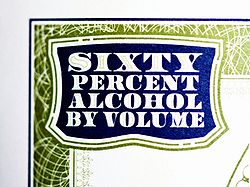- Alcohol by volume
-
"ABV" redirects here. For other uses, see ABV (disambiguation).
 The alcohol by volume shown on a bottle of absinthe.
The alcohol by volume shown on a bottle of absinthe.
Alcohol by volume (abbreviated as abv, ABV, or alc/vol) is a standard measure of how much alcohol (ethanol) is contained in an alcoholic beverage (expressed as a percentage of total volume).[1][2][3] The ABV standard is used worldwide.[4]
In some countries, alcohol by volume is referred to as degrees Gay-Lussac (after the French chemist Joseph Louis Gay-Lussac).[5]
Contents
Typical levels
Details about typical amounts of alcohol contained in various beverages can be found in the articles about individual drinks.
Drink Typical ABV Fruit juice (naturally occurring) less than 0.1% Low-alcohol beer 0.0%–1.2% Kvass 0.05%–1.5% Kombucha 0.5%–1.5% Boza 1% Chicha 1%–11% (usually 1%–6%) Cider 2%–8.5% Beer 2%–12% (usually 4%–6%) Alcopops 4%–17.5% Malt liquor 5%+ Makgeolli 6.5%–7% Barley wine (strong ale) 8%–15% Mead 8%–16% Wine 9%–16% (most often 12.5%–14.5%)[6] Dessert wine 14%–25% Sake (rice wine) 15% (or 18%–20% if not diluted prior to bottling) Liqueurs 15%–55% Fortified wine 15.5%–20%[7] (in the European Union, 18%–22%) Soju 17%–45% (usually 19%) Shochu 25%–45% (usually 25%) Bitters 28%–45% Mezcal, Tequila 32%–60% (usually 40%) Vodka 35%–50% (usually 40%) Brandy 35%–60% (usually 40%) Rum 37.5%–80% Ouzo 37.5%+ Cachaça 38%–54% Sotol 38%–60% Nalewka 40%–45% Gin 40%–50% Whisky 40%–55% (usually 40% or 43%) Baijiu 40%–60% Chacha 40%–70% Pálinka 42%–86% (legally in Hungary ≤51%) Rakija 42%–86% Absinthe 45%–89.9% Ţuica 45%–60% (usually 52%) Poitín 60%–95% Neutral grain spirit 85%–95% Cocoroco 93%–96%[citation needed] Rectified spirit 95%-96% Absolute alcohol (ethanol) 99%+ Alcohol proof
Another way of specifying the amount of alcohol is alcohol proof, which in the United States is twice the alcohol-by-volume number,[8][9] while in the United Kingdom it was 1.75 times the number (expressed as a percentage). For example, 40% abv is 80 proof in the US and 70 proof in the UK. However, since 1980, alcoholic proof in the UK has been replaced by abv as a measure of alcohol content.
Proof and alcohol by weight
In the United States, a few states regulate and tax alcoholic beverages according to alcohol by weight (abw), expressed as a percentage of total mass. Some brewers print the abw (rather than the abv) on beer containers, particularly on low-point versions of popular domestic beer brands.
At relatively low abv, the alcohol percentage by weight is about 4/5 of the abv (e.g., 3.2% abw is equivalent to 4.0% abv).[10] However, because of the miscibility of alcohol and water, the conversion factor is not constant but rather depends upon the concentration of alcohol. 100% abw, of course, is equivalent to 100% abv.
Calculation of alcohol content
During the production of wine and beer, yeast is added to a sugary solution. During fermentation, the yeast organisms consume the sugars and produce alcohol. The density of sugar in water is greater than the density of alcohol in water. A hydrometer is used to measure the change in specific gravity (SG) of the solution before and after fermentation. The volume of alcohol in the solution can then be calculated.
Wine
The simplest method for wine has been described by C.J.J. Berry:[11]
- ABV = (StartingSG − FinalSG) / 7.36
Beer
Main article: Beer_measurement#By_strengthThe calculation for beer is:
Where 1.05 is number of grams of ethanol produced for every gram of CO2 produced and .79 is the density of ethanol alcohol,
- ABV = ((1.05 * (Starting SG – Final SG)) / Final SG) / 0.79 * 100[citation needed]
However, many brewers use the following formula:
- ABV = (Starting SG - Final SG) * 131
See also
References
- ^ "Lafayette Brewing Co. Beer Terms". www.lafayettebrewingco.com. http://www.lafayettebrewingco.com/beer101.html. Retrieved 2008-07-05.
- ^ "Glossary of whisky and distillation". www.celtic-whisky.com. http://www.celtic-whisky.com/glossary.htm. Retrieved 2008-07-05.
- ^ "English Ales Brewery Monterey British Brewing Glossary". www.englishalesbrewery.com. http://www.englishalesbrewery.com/british-brewing-glossary.htm. Retrieved 2008-07-05.
- ^ "Frequently Asked Questions - CAMRA". www.camra.org.uk. http://www.camra.org.uk/page.aspx?o=181061. Retrieved 2008-07-05.
- ^ "Joseph Louis Gay-Lussac (1778–1850)". chemistry.about.com. http://chemistry.about.com/od/famouschemists/p/gaylussacbio.htm. Retrieved 2008-07-05.
- ^ Robinson, Jancis. The Oxford Companion to Wine, 3rd edition, (Oxford University Press: 2006). See alcoholic strength at p. 10.
- ^ Robinson, Jancis. The Oxford Companion to Wine, 3rd edition, (Oxford University Press: 2006). See fortification at p. 279.
- ^ C.J.J. Berry, 1987, First Steps in Winemaking, eighth edition, Special Interest Model Books Ltd, printed in UK
- ^ Regan, Gary (2003). The Joy of Mixology. New York: Clarkson Potter. pp. 356–357. ISBN 0-609-60884-3.
- ^ "Realbeer.com: Beer Break - Alcohol Content In Beer". www.realbeer.com. http://www.realbeer.com/library/beerbreak/archives/beerbreak20001005.php. Retrieved 2008-07-05.
- ^ C.J.J. Berry, 1987, First Steps in Winemaking, eighth edition, Special Interest Model Books Ltd, printed in UK
Bibliography
- Hehner, Otto (1880). Alcohol Tables: giving for all specific gravities, from 1.0000 to 0.7938, the percentages of absolute alcohol, by weight and volume. London: J & A Churchill, ASIN B0008B5HOU.
External links
Categories:- Alcohol measurement
Wikimedia Foundation. 2010.
